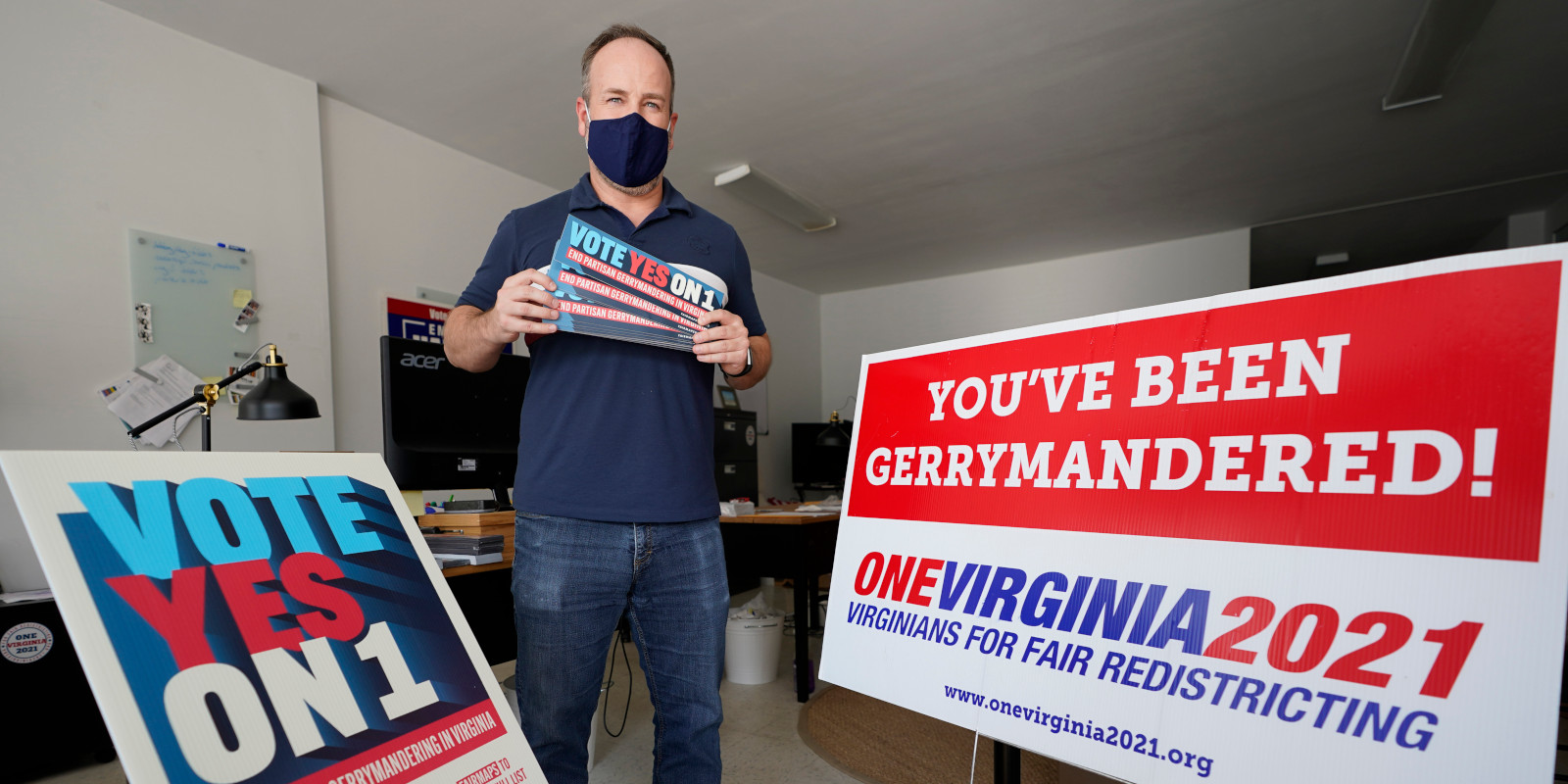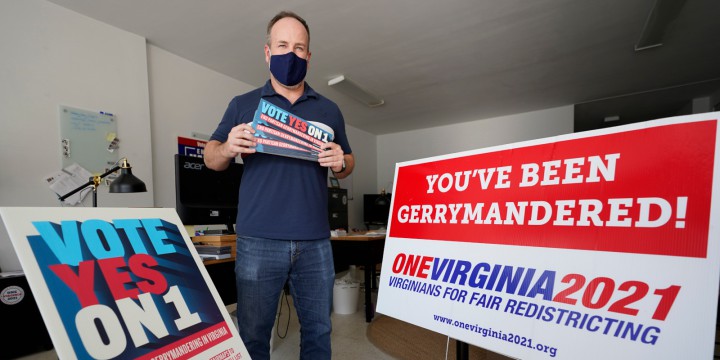This episode of Hub Dialogues features host Sean Speer in conversation with University of North Florida political scientist Nicholas Seabrook about his fascinating new book, One Person, One Vote: A Surprising History of Gerrymandering in America.
The discussion touches on the surprising history of gerrymandering in America, why it is so entrenched, and what can be done to fix it.
You can listen to this episode of Hub Dialogues on Acast, Amazon, Apple, Google, Spotify, or YouTube. A transcript of the episode is available below.
Transcripts of our podcast episodes are not fully edited for grammar or spelling.
SEAN SPEER: Welcome to Hub Dialogues. I’m your host Sean Speer, editor-at-large at The Hub. I’m honoured to be joined today by Nicholas Seabrook, a professor of political science at the University of North Florida, an author of the fascinating new book, One Person, One Vote: A Surprising History of Gerrymandering in America. Nicholas, thank you for joining us at Hub Dialogues, and congratulations on the book.
NICHOLAS SEABROOK: Hey, Sean. Thanks. It’s great to be here.
SEAN SPEER: It’d be great if we could start with a scene-setting question. What is meant by the idea of gerrymandering? How does it manifest itself in U.S. politics? And is there a lot of variation across states in terms of how electoral boundaries are set?
NICHOLAS SEABROOK: One of the things that I focus on in the book is the fact that gerrymandering, as we understand it today, is pretty much a uniquely American phenomenon. Your listeners may be familiar with how the redistricting, or redistribution as you call it in Canada, works. In most other nations, a lot of them follow a model that’s similar to what happens throughout the British Commonwealth, where you have some kind of independent entity, the boundary commissions in Canada, similar things in the U.K., Australia, and New Zealand, where the drawing of the district that candidates will run in that will elect members of the House of Commons, or whatever the legislative chamber is, are done independently.
The idea is that when you have politicians themselves directly involved in the redistricting process, it creates some really bad incentives. Those politicians want their side to win elections. They want to keep their own seats in government, and not infrequently they will use the redistricting process to ensure that those things occur. That’s basically what we mean by gerrymandering.
It’s the drawing of the district in such a way as to make more likely a certain political outcome, whether it’s one side keeping control, or politicians retaining their seats. The U.S., unlike most other advanced democracies, maintains this system where the political branches of government in the majority of states still have control over the redrawing of districts. What I do in the book is really look at how this has manifested itself, going all the way back in U.S. history, because it turns out that gerrymandering in America is older than the United States itself.
I found examples from the colonial era. I found that the framers of the U.S. Constitution themselves were not averse to a little gerrymandering. That has really continued up until the present day, as all of these other countries have figured out that leaving politicians in control of this process is a bad idea, yet the U.S. has been stubbornly immune to redistricting reform.
There has been some progress. Some states have taken steps to remove this process from politics, but far too many have not and we’re seeing that play out in the U.S. right now. Every 10 years we get another round of gerrymandering, another round of hand-wringing about how bad it is, and not a whole lot happens. I wrote the book to try and inspire people to actually fix this moving forward.
SEAN SPEER: We’ll come to your latest book including its historical analysis and then its forward-looking recommendations in a minute, but if we can talk for a second about your previous book, your 2017 book Drawing the Lines, which generated considerable attention because while you called gerrymandering undemocratic, you also challenge the conventional wisdom that it’s had significant effects on political competition, and in turn, represents something of a threat to U.S. democracy. Can you please unpack what you concluded and how it was received?
NICHOLAS SEABROOK: I think there’s always been a little bit of a disconnect between how redistricting and gerrymandering are viewed both by politicians and the public and the way that they’re viewed by political scientists. I think political science has always emphasized somewhat more that there’s more to this story, and that there are trade-offs involved however you choose to approach redistricting. What I examined in that book was the implications of political control of redistricting, not only for bias, whether it’s bias towards one political party or towards incumbents, but also towards electoral competitiveness as well.
I found that one of the interesting side effects of gerrymandering, at least as it occurred in the time period that I studied, which was the 1990s and the 2000s, one side effect was that gerrymandering did tend on average to produce more competitive districts when it was partisan than when you just saw the politicians compromising and protecting all of the incumbents.
A lot of that was comparing different types, different flavours of American gerrymandering, the constraints that were involved in them, and the outcomes that they produced. While I do stand by the book, I also think that in the last couple of decades there has been a shift in the way that a lot of the people involved in gerrymandering have tended to approach it. A recognition that with the technology that we have today with the data that we have today, you can produce that bias in the system without necessarily having to increase competition at the same time.
I think that’s been the big downside. It began with the Republican party’s REDMAP project after the 2010 census. I think the level of sophistication in gerrymandering over the last couple of decades has represented a new evolution of the phenomenon. That’s been my approach in this follow-up book, to trace that development over time. You can go back and look at gerrymandering from prior eras. A lot of times it wasn’t all that successful, consistent with the story from my first book, but I think that really has changed in the last couple of decades. That’s why I see it as a much bigger threat today than it may have been even 10, 15 years ago.
SEAN SPEER: One more big picture question for listeners, Nicholas, before we shift to the key insights and findings of the most recent book. You talked about the potential impact on political competition. Let me just ask you, are there any secondary effects to gerrymandered districts? Is there any evidence, for instance, that it may have indirect effects on congressional voting patterns or the typical longevity of political careers or something else that may not be reflected merely in assessing the impact on electoral competition?
NICHOLAS SEABROOK: I think the research in political science has been pretty consistent in uncovering that gerrymandering is a symptom of the broader democratic malaise that we’re seeing in the United States rather than a driving force behind some of these things. There’s been studies that have looked at whether redistricting or gerrymandering has contributed to the high degree of political polarization that we see in the United States. I think the findings from that have fairly consistently shown that while gerrymandering is not a contributor towards polarization, the fact that you have all of that polarization means that we get gerrymandering more often, and it can be easier to achieve when people are so divided.
Similarly, we’ve had a long trend in U.S. elections towards districts being less competitive. Part of the downside of that is that elections are increasingly decided in the primary rather than in the general election. Again, while gerrymandering has not been driving that change, the fact that districts are less and less competitive makes the effects of gerrymandering more significant. I think it’s more that the changes in gerrymandering have been moving in parallel with other negative developments. When you add all of those things together, it is really, really bad for the health of democracy. I also think that gerrymandering is probably the easiest of those things to fix.
It’s very hard to change people’s worldviews, belief systems, and partisanship. It’s much easier to just make a simple change of, “Okay, we’re no longer going to allow politicians to be involved in this process.” That’s not going to be a panacea, but it’s something that you can fix and maybe at the margins can help with some of these other problems that we’re experiencing.
SEAN SPEER: Okay. That’s great context to permit us now to delve into your latest book, One Person, One Vote.
As you mentioned earlier, Nicholas, you’ve come back to the issue in this latest book, which amongst other things aims to discern the origins of gerrymandering and how it’s evolved over U.S. history. What were you hoping to find, and what would you say is the big takeaway? What was surprising as the book’s title suggests?
NICHOLAS SEABROOK: I would say probably the most surprising thing is that what I at least had always assumed was the origin story of gerrymandering. The first quote-unquote gerrymandering not only was not the first gerrymandering, there were numerous examples of it occurring in the United States prior to the infamous Salamander district that was drawn in Massachusetts back in 1812, which became associated with the governor of the state at the time, a guy by the name of Elbridge Gerry.
Perhaps the most surprising thing was that I learned that it was originally called “gerrymandering” and it was only over time that the more natural pronunciation of it as “gerrymandering” caught on and eventually entirely replaced the original way that the word had been pronounced.
I think one of the things that the book does is to some extent vindicate Elbridge Gerry, hopefully, in the court of history for the fact that he is considered to be responsible for this practice because not only did it predate his association with it, even though it was eventually named after him, but he was really not all that involved in the original “gerrymander” or gerrymander.
It was very much his political associates in the Massachusetts legislature at the time who had been really pushing to redraw the districts to try and give them an edge over their Federalist opponents. Gerry, if you believe some of the stuff that was written at the time, and I think I do, was just along for the ride. He wasn’t driving the car. He signed the redistricting plan into law. It came to be associated with him, but it really wasn’t his brainchild and it wasn’t something that he put front and centre in his agenda. Hopefully, his descendants will be happy with the fact that this clears his name in the court of his history as being the one who we have to blame for everything that’s happening today.
SEAN SPEER: You took up this point a bit earlier, but I’ll ask you to elaborate. Based on your historical analysis, is gerrymandering in America getting better or worse, and either way, what do you attribute the trend to?
NICHOLAS SEABROOK: I would say that it is getting worse largely because of the technology that is now available for the people who are doing it. One of the historical gerrymanders that I talk about in the book happened in 1788 in Virginia, and there it was Patrick Henry going up against James Madison and attempting to draw a district that would prevent him from getting elected to the first Congress, the legislative body that gave us the Bill of Rights. Madison obviously was central to that process. He was the author of those amendments.
Patrick Henry’s effort to gerrymander Madison out of the first Congress was fairly unsophisticated. He really didn’t know what the voting populations in the state looked like. He gave it his best effort, he looked at how different places voted when it came to sending delegates to the constitutional convention and figured that that would be a rough proxy for how they felt about Madison. He recruited the biggest heavyweight that he could find to run against Madison in the form of James Monroe. This remains the only time in U.S. history that two future presidents have faced off against one another for a single seat in Congress.
Even with all that, Madison went on to win the election in a near landslide. There was certainly not a lack of will when it came to these early gerrymanders, but there was very much a lack of the tools to be able to follow through. It really wasn’t until the 1980s, when we saw the first rudimentary computer software that was used for drawing districts, that things started to become more sophisticated. And it really wasn’t until the last two decades, really the last 12 years, the last two redistricting cycles, where it’s not just having data available that’s going to tell you, “Okay, here’s where the Democrats are, here’s where the Republicans are,” it’s also having the models to be able to simulate what will happen once those districts are drawn.
You don’t have to say, “Well, okay, if we put 55 percent of Republicans in this district, is that likely to be enough? Maybe we should put 60. Maybe we should put 65.” Now, what they can do is say, “Okay, we’ve drawn this district. Let’s simulate a decade’s worth of elections and see what happens if we start to see a shift in one direction or the other? What happens if there’s a Republican wave in one year and their presidential candidate does really well?” Then they can use that information to finetune the gerrymander to remain robust across a whole range of hypothetical future developments.
That’s what I think is really new today that hasn’t been the case previously. That’s also why I think they’ve realized that they don’t have to draw a whole lot of competitive districts to make a gerrymander work. That they can create a lot of safe seats, and that gives them that added layer of security of certainty that it’s going to be robust across an entire decade. We have U.S. states where the Republicans controlled redistricting after 2010 and they have never lost their majority since then. Places like Wisconsin, for instance, where the GOP has controlled close to two-thirds of the seats in their legislature, even in elections since then when they’ve lost the popular vote overall. That’s what I see as being really the new development when it comes to gerrymandering.
SEAN SPEER: Are Republicans or Democrats more guilty of exploiting gerrymandering or do they use it in broadly similar ways?
NICHOLAS SEABROOK: I think they’re both as guilty. The Republicans have been more successful at least in the last couple of cycles, but that has been more an accident of the fact that the Republicans had a really, really good year in 2010. Obama was not especially popular at the time. The Republicans swept into control in state legislatures in a lot of states that were not deep-red states, places like Wisconsin, Michigan, Ohio, Pennsylvania, North Carolina, and here in Florida as well.
You had this confluence of events where the technology is now there to create gerrymanders that are really, really effective. It just happens that the Republicans are now in control in many, many more states than Democrats are. I think Democrats were caught a little bit flat-footed by that. In this most recent decade, they’ve been fighting back. We’ve seen in places like New York, in places like Illinois, in New Jersey, in Maryland, that the Democrats have come equipped with the same set of tools.
They have suffered from the fact that the judiciary has, in the states where Democrats are in control, pushed back a little bit more against some of their gerrymanders. I think both historically and contemporaneously, this is something that every political party has been guilty of. Democrats, Republicans—I talked about gerrymanders by the Whigs back in the 1840s in the book, you could go back even further, Democratic, Republicans, and Federalists—this is something that no political party seems to be able to resist when those districts are on the table, and they have an opportunity to use it to gain an edge over their opponents. It’s very, very rare that a political party doesn’t push that advantage.
SEAN SPEER: As an aside, Nicholas, I’m speaking to you from the Upper West Side in New York City, which was subject to gerrymandering in the last round of redistricting, and it’s now a perfectly calibrated district, which involves part of Manhattan, through Park Slope and Brooklyn. The result is a kind of perfectly calibrated Democratic district in part of the city that at different times has been more competitive. As you say, increasingly, in the states in which the different parties have a foothold, they’re entrenching or codifying that foothold through some of these processes.
Let me step back for a second and ask you a big picture question that I was thinking about as I prepared for today’s conversation. Notwithstanding the impact that gerrymandering is having, or is reflective of at the local level, one of the extraordinary things about the state of U.S. politics is just how competitive it’s been in the aggregate over the past couple of decades. What do you attribute that to? How has America become, in effect, a 50/50 country of some sort?
NICHOLAS SEABROOK: I think that’s more of a general tendency in a two-party system at the kind of the highest level of aggregation when it comes to running for national offices, and I think this has also been true not necessarily for all of U.S. history, but you go back to a lot of the elections in the late 19th century, for instance, that the issues were entirely different. A lot of it was about tariffs, whether Republicans or Democrats were for or against particular tariffs, but a lot of those elections were really competitive as well.
I think the period from the New Deal through the Civil Rights Movement when Democrats really dominated at the presidential level, but even more so in Congress, was something of an artificial period. You had the New Deal Coalition that FDR was able to assemble. That was very much cross-ideological, where you had a lot of Southern Democrats who were very conservative and then you had the party’s base, outside of the South, which was very much kind of working-class liberals, very much union based.
That coalition really started to crumble in the aftermath of the Civil Rights Movement, when gradually, and this process took several decades to fully manifest, but conservative white southerners abandoned the Democratic Party and embraced the GOP. I think that’s why that period of time disappeared, and why at the national level things are much more competitive now because the parties are more aligned ideologically.
You have the left pretty much voting for Democrats, the right pretty much voting for Republicans, and in the two-party system, the political parties naturally orient themselves towards that coalition. And as the middle disappears, you increasingly just have these two camps screaming at each other across the divide and that’s the situation we find ourselves in now. I think there’s a natural tendency in a system where it’s dominated by two parties that they orient their policies towards putting together a coalition that’s going to allow them to compete at the national level.
SEAN SPEER: I suspect that listeners have been persuaded by your case that the process of gerrymandering ought to be subject to reform. The natural question is, how do you build political support for the reform agenda? Are there models in some of the U.S. states that have moved in a more independent direction that look the most promising as a kind of catalyst or basis for reform? Do you want to talk a bit about that?
NICHOLAS SEABROOK: Yes, what we’ve seen over the last 10 years, in particular, has been a proliferation of a kind of patchwork of redistricting reform and it’s taken various different forms. I think what is clear is that the most effective way to address this is the way that other nations have done so, which is to simply remove the power for drawing districts from politicians. That gets you most of the way towards fixing the problem.
Some of the reforms that have been less successful have been ones that have attempted to place constraints on politicians. This is what we’ve tried here in Florida. Back in 2010, the voters of Florida approved two new amendments to the constitution, which basically said, “Okay, we’re going to leave the state legislature in control, but they’re not allowed to gerrymander.” Then what immediately happened was that they went ahead and gerrymandered anyway.
Eventually—it took four or five years—the state supreme court did eventually strike down both the congressional map and the state senate map that were in place in Florida. Last decade, we did get fair districts, but lawsuits are time-consuming and costly and not guaranteed for success in the way of combating gerrymandering. Which is why in the book I really advocate for a different model, which is the Citizens Redistricting Commission.
This is something that’s been tried in three different states at this point. California put their Citizens Redistricting Commission in place a decade ago. This time around both Colorado and Michigan have adopted similar reforms. Independent commissions are not always going to give you 100 percent fair districts. We see this elsewhere as well in other countries that have a boundary commission or something similar. But at the very least, it’s going to give you a fair process, and one where every trade-off isn’t being pushed in the direction of, “How does this benefit me or my political party?” You have regular people who are selected generally at random, who have to apply, and who kind of go into this without all of that political baggage that tends to attach itself when it’s politicians who are doing it.
If I had to make a recommendation, that would be the recommendation that I would make because we have it. It’s in various states, it seems to be working reasonably well. Every time Americans are given the opportunity to actually vote on this, gerrymandering reform tends to do really well. We saw that with the initiatives here in Florida, and we saw that with various ballot initiatives in a whole host of other states.
The problem is that you don’t have that option available everywhere. So, if you’re in a state that doesn’t have some kind of direct democracy, you’re left trying to convince the politicians in your state legislature to voluntarily give up this power, which is much more of an uphill battle. I think there’s also a lot of room for Congress to address this problem as well when it comes to federal elections and we’ve seen bills proposed.
The problem is that they have gone nowhere in the Senate. They’ve been attached to these kinds of omnibus voting rights bills, where there are things in there that are controversial. Even though I think a lot of Republicans dislike gerrymandering as much as Democrats do, the problem in the Senate has been that the gerrymandering reform is attached to all of these other things. There are plenty of reasons that Republicans have to oppose those omnibus bills overall.
I would like to see Congress introduce gerrymandering reform as a standalone bill, and find out where people stand on it because polling and indeed voting suggests that Americans are overwhelmingly in favour of fixing gerrymandering. It’s just a case of giving them the opportunity to actually do so.
SEAN SPEER: Let me ask a final question. You said earlier, Nicholas, that while you are a major proponent of redistricting reform, you recognize that it’s not a panacea for some of the deeper issues in American politics. May I just ask if you have any other thoughts to improve or mitigate the trend toward polarization and political dysfunction in the United States?
NICHOLAS SEABROOK: I think that’s considerably more challenging, and in particular because a lot of it is cultural at this point, that being a Democrat, being a Republican has become part of your cultural identity and there’s just no common ground there on a lot of the issues that we’re facing.
I think one thing that might be a profitable avenue to explore is, even more broadly than just the gerrymandering issue, the problem of our districts becoming so uncompetitive, the decline of competitive seats in Congress and in state legislatures. Because that I think magnifies the problem considerably when you have the primary electorate basically picking the candidates and primary voters tend to be more ideologically extreme.
That’s why we’re seeing people getting elected to not just state legislatures, but people getting elected to Congress who have some really way-out-there beliefs. When you look at the district they’re running in, it’s like a Republican plus-50 district or something like that, where there’s no meaningful opportunity for the other side to compete and to contest. In terms of political solutions, I think there are broader cultural and societal issues that I’m not qualified to address or to suggest how we might go about fixing them, but politically, I just think, and this was my big recommendation from my first book, which was that we need to have more competitive districts.
We need to have more seats in which the outcome is in doubt and that’s how you get an electoral system that’s more responsive to the people. As politicians know that they’re going to lose if they do things that are unpopular, I think that starts to build that responsiveness and to build some of that trust back into the system. And perhaps over time that starts to fix some of the other problems as well.
SEAN SPEER: Well, a big part of that process should start by reading Nicholas Seabrooks’s new book, One Person, One Vote: A Surprising History Of Gerrymandering In America. Nicholas, thank you so much for joining us today at Hub Dialogues.
NICHOLAS SEABROOK: Thanks, Sean. It’s been fun.
Recommended for You

Ginny Roth: J.D. Vance, Pierre Poilievre, and how they slice their economic pie

David Polansky: As President Biden leaves the race, will the Democratic Party hodgepodge hold?

Peter Menzies: The mainstream media should love Doug Ford, now that he’s subsidizing them

Geoff Russ: A future Conservative government must fight the culture war, not stand idly by



